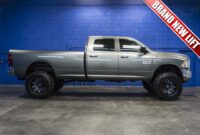Long Haul Trucking Insurance Markets: Navigating the Complexities of Coverage sale.truckstrend.com
Long haul trucking is the backbone of global commerce, responsible for transporting everything from consumer goods to industrial materials across vast distances. While this industry is vital, it also operates in an environment fraught with significant risks. From adverse weather conditions and driver fatigue to mechanical breakdowns and high-value cargo theft, the potential for incidents is ever-present. This inherent risk makes comprehensive and robust insurance coverage not just a regulatory requirement, but an absolute necessity for any trucking operation.
The Long Haul Trucking Insurance Market refers to the intricate ecosystem of insurance providers, brokers, underwriters, and the trucking companies themselves, all interacting to facilitate the transfer and management of these substantial risks. Understanding this market is crucial for truck owners, fleet managers, and owner-operators alike, as it directly impacts their operational costs, financial stability, and ability to remain compliant and competitive. Navigating this specialized market requires insight into its unique demands, fluctuating conditions, and the strategic approaches that can secure optimal protection.
Long Haul Trucking Insurance Markets: Navigating the Complexities of Coverage
Understanding the Unique Risks of Long Haul Trucking
The nature of long haul trucking introduces a distinct set of risks that demand specialized insurance solutions. Unlike local delivery, long haul operations face:
- Extended Exposure: Drivers spend days or weeks on the road, increasing exposure to varied weather conditions, road hazards, and potential for driver fatigue.
- High-Value Cargo: Freight often consists of expensive goods, meaning cargo damage or theft can lead to substantial financial losses.
- Regulatory Complexity: Operating across state lines or international borders involves navigating a labyrinth of federal, state, and sometimes international regulations, including specific insurance minimums set by bodies like the FMCSA (Federal Motor Carrier Safety Administration).
- Severe Accident Potential: The sheer size and weight of commercial trucks mean that accidents, when they occur, often result in severe property damage, serious injuries, or even fatalities, leading to very high liability claims.
- Equipment Downtime: Breakdowns far from a home base can lead to significant repair costs, towing fees, and lost revenue due to delayed deliveries.
- Driver-Related Risks: Issues such as driver shortages, high turnover, and the need for continuous training contribute to the overall risk profile, as inexperienced or fatigued drivers are more prone to accidents.

These factors necessitate a comprehensive insurance portfolio designed to mitigate financial fallout from a wide array of potential incidents.
Key Types of Long Haul Trucking Insurance Coverage
Securing adequate coverage involves understanding the various types of policies available, each addressing a specific facet of risk:

- Primary Auto Liability Insurance: This is the cornerstone of any trucking insurance policy and is federally mandated. It covers bodily injury and property damage to third parties in an accident where your truck is at fault. Minimum coverage varies but is typically $750,000 for general freight, increasing significantly for hazardous materials (often $1,000,000 to $5,000,000+).
- Physical Damage Insurance: Protects your truck and trailer from damage due to collisions, fire, theft, vandalism, or natural disasters. It typically includes:
- Collision Coverage: For accidents involving other vehicles or objects.
- Comprehensive Coverage: For non-collision incidents like theft, fire, or falling objects.
- Cargo Insurance: Essential for protecting the goods you are transporting. This policy covers loss or damage to the freight due to events like theft, fire, collision, or improper handling. Coverage limits should align with the maximum value of the cargo you typically haul.
- General Liability Insurance: Covers non-driving related incidents that occur at your business premises or during operations, such as a slip-and-fall accident at a loading dock or property damage caused by your operations but not directly involving your truck.
- Non-Trucking Liability (Bobtail) Insurance: Crucial for owner-operators who drive their truck for personal use (e.g., driving home after a delivery) when not under dispatch by a motor carrier. It covers liability during these non-revenue generating periods.
- Trailer Interchange Insurance: If you regularly pull trailers owned by other trucking companies or shippers under a trailer interchange agreement, this coverage protects those non-owned trailers from damage while they are in your possession.
- Uninsured/Underinsured Motorist Coverage: Protects you and your drivers if you are involved in an accident with another motorist who is at fault but either has no insurance or insufficient coverage to cover your damages.
- Occupational Accident Insurance: Often chosen by owner-operators, this provides benefits similar to Workers’ Compensation for work-related injuries or illnesses, covering medical expenses and lost wages.
- Downtime Coverage: Not always standard, but some policies offer coverage for lost income when your truck is out of service due to a covered claim.
Factors Influencing Long Haul Trucking Insurance Premiums
Insurance premiums in the long haul sector are highly variable, determined by a complex interplay of factors:
- Driver History and Experience: The driving records (MVRs) of all drivers are paramount. A clean record, extensive experience, and positive CSA scores lead to lower premiums. Conversely, violations, accidents, or a lack of experience will significantly increase costs.
- Fleet Size and Type: Larger fleets may qualify for volume discounts, but the age and type of equipment (e.g., specialized vehicles, older trucks) also play a role. Newer trucks with advanced safety features might fetch better rates.
- Operating Radius and Routes: Carriers operating across the entire country or in high-traffic, high-risk areas (e.g., major metropolitan centers, challenging terrains) will generally pay more than those with limited, less hazardous routes.
- Cargo Type: Hauling hazardous materials, oversized loads, or high-value commodities (like electronics or pharmaceuticals) carries higher risk and thus higher premiums due to the increased potential for severe damages or losses.
- Loss History: A history of frequent or severe claims will signal higher risk to insurers, leading to increased premiums. Conversely, a clean claims record can significantly reduce costs.
- Safety Programs and Technology: Companies that demonstrate a commitment to safety through robust training programs, regular vehicle maintenance, and the use of telematics, dash cams, and Advanced Driver-Assistance Systems (ADAS) may qualify for discounts. Improved CSA scores are critical here.
- Deductibles and Coverage Limits: Opting for higher deductibles (the amount you pay out-of-pocket before insurance kicks in) can lower your premium. However, it means accepting more financial risk per incident. Similarly, higher coverage limits increase premiums but offer greater protection.
- Market Conditions: The overall state of the insurance market – whether it’s a "hard" market (premiums are rising, capacity is shrinking, underwriting is stricter) or a "soft" market (premiums are decreasing, more competition among insurers) – significantly impacts rates. The long haul trucking insurance market has largely been in a "hard" cycle in recent years.
Navigating the Insurance Market: Practical Advice and Actionable Insights
Securing the right long haul trucking insurance at a competitive rate requires a proactive and informed approach:
- Partner with a Specialized Broker: Do not use a general insurance agent. Work with an independent insurance broker who specializes specifically in commercial trucking. They have access to multiple carriers, understand the nuances of the industry, and can tailor policies to your unique needs.
- Prioritize Safety and Risk Management: This is the single most impactful way to control your insurance costs long-term. Implement rigorous driver training programs, conduct regular safety audits, maintain excellent CSA scores, and invest in safety technology (telematics, dash cams). A strong safety culture translates directly into lower claims and better rates.
- Maintain Detailed Records: Keep meticulous records of driver training, vehicle maintenance, and accident reports. This data can be invaluable when negotiating premiums or disputing claims.
- Understand Your Needs Thoroughly: Before getting quotes, clearly define your operating radius, types of cargo, typical routes, and desired coverage limits. Don’t pay for coverage you don’t need, but never skimp on essential protection.
- Shop Around (But Be Thorough): Get quotes from several reputable carriers through your specialized broker. Compare not just prices, but also policy terms, exclusions, and the insurer’s claims handling reputation.
- Review Policies Annually: Your business changes, and so do market conditions. Review your policies at least once a year with your broker to ensure your coverage remains adequate and competitive. Adjust limits or add/remove coverage as needed.
- Consider Higher Deductibles (Strategically): If your business has a healthy cash reserve, opting for a higher deductible can reduce your annual premium. Just ensure you can comfortably cover that deductible in case of a claim.
- Bundle Policies: Some insurers offer discounts if you purchase multiple policies (e.g., liability, physical damage, and cargo) from them.
Current Challenges and Future Trends in the Market
The long haul trucking insurance market is dynamic and currently faces several significant challenges:
- Rising Claims Costs and "Nuclear Verdicts": The cost of vehicle repairs, medical expenses, and litigation continues to escalate. "Nuclear verdicts" – jury awards exceeding $10 million – are a growing concern, driving up liability premiums across the board.
- Driver Shortage and Turnover: The ongoing shortage of qualified drivers impacts safety and increases the risk of accidents with less experienced personnel, pushing up insurance costs.
- Inflation: General inflation affects the cost of parts, labor, and medical care, which directly translates to higher claims costs for insurers and, subsequently, higher premiums for carriers.
- Technology Adoption: While technologies like telematics and ADAS can reduce risk, their initial cost and the complexity of integrating them can be a barrier for some smaller carriers. Insurers are increasingly looking for adoption of these technologies.
- Cybersecurity Risks: As trucking operations become more digitized, the risk of cyberattacks impacting logistics, cargo tracking, and financial data is growing, necessitating new forms of cyber insurance.
- Market Hardening: The market has been in a "hard" cycle for several years, characterized by fewer insurers willing to take on high-risk accounts, higher premiums, and more stringent underwriting requirements. This means carriers with poor safety records or high loss histories may struggle to find coverage or face extremely high rates.
Representative Long Haul Trucking Insurance Premium Ranges
It is crucial to understand that actual premiums vary wildly based on the factors discussed above (driver history, cargo type, operating radius, claims history, safety programs, etc.). The following table provides highly generalized annual premium ranges for a single truck operation. Fleet operations will have different pricing structures.
| Coverage Type | Estimated Annual Premium Range (per truck) | Key Influencing Factors |
|---|---|---|
| Primary Liability | $8,000 – $20,000+ | Coverage limits (e.g., $1M, $2M), cargo type, operating radius, driver MVR, CSA scores, loss history |
| Physical Damage | $2,000 – $5,000+ | Value of truck/trailer, age of equipment, deductible chosen, claims history, type of coverage (collision/comp) |
| Cargo Insurance | $500 – $2,500+ | Cargo value limits, type of cargo (e.g., general freight vs. hazardous/high-value), security measures, claims history |
| General Liability | $500 – $2,000 | Business operations (e.g., office only vs. warehouse), number of employees, prior claims |
| Non-Trucking Liability | $400 – $800 | Driver history, operating area |
| Trailer Interchange | $300 – $1,000+ | Value of non-owned trailers, frequency of use, deductible |
| Occupational Accident | $1,500 – $3,000+ | Number of owner-operators, state regulations, benefits chosen |
| Total Estimated Annual Premium (Per Truck) | $13,200 – $35,000+ | All factors listed above, plus specific insurer rates and market conditions |
Disclaimer: These figures are illustrative and highly variable. They are provided for general informational purposes only and should not be taken as an exact quote. Always consult with a specialized trucking insurance broker for an accurate assessment of your specific needs and a customized quote.
Frequently Asked Questions (FAQ)
Q1: What is a "hard" insurance market vs. a "soft" market?
A1: In a "hard" market, insurance premiums are generally rising, capacity (the amount of coverage available) is decreasing, and underwriting standards become stricter. This is often due to high claims costs or catastrophic losses. In a "soft" market, premiums are stable or decreasing, and there’s more competition among insurers, leading to more favorable terms for buyers. The long haul trucking market has been largely "hard" recently.
Q2: How can I lower my long haul trucking insurance premiums?
A2: The most effective ways are to maintain an impeccable safety record (low CSA scores, few accidents), invest in driver training and retention, utilize safety technology (telematics, dash cams), select higher deductibles if financially feasible, and work with an experienced, specialized insurance broker to shop for the best rates.
Q3: What is a CSA score, and why is it important for insurance?
A3: CSA (Compliance, Safety, Accountability) scores are part of an FMCSA program that measures a motor carrier’s safety performance in various categories (e.g., unsafe driving, fatigued driving, vehicle maintenance). Insurers heavily rely on CSA scores to assess risk. High (poor) CSA scores indicate a higher risk of accidents and will lead to significantly higher premiums or even difficulty obtaining coverage.
Q4: Do I need separate insurance for my trailer if I don’t own it?
A4: Yes, if you pull trailers owned by others under a formal agreement, you typically need Trailer Interchange Insurance. If you are simply hauling a customer’s loaded trailer as part of a transport contract, your primary liability and cargo insurance should generally cover it, but always confirm with your insurer.
Q5: What is a deductible in trucking insurance?
A5: A deductible is the amount of money you must pay out-of-pocket for a covered loss before your insurance coverage begins to pay. For example, if you have a $2,500 deductible on your physical damage policy and your truck sustains $10,000 in damage, you pay the first $2,500, and your insurer pays the remaining $7,500. Choosing a higher deductible can lower your annual premium, but means more out-of-pocket risk per incident.
Q6: How often should I review my trucking insurance policy?
A6: You should review your policy at least annually with your insurance broker, typically before renewal. This allows you to adjust coverage based on changes in your operations (e.g., expanding routes, acquiring new equipment, changing cargo types), driver roster, or evolving market conditions.
Conclusion
The long haul trucking insurance market is a complex but indispensable component of the transportation industry. It serves as a vital safeguard against the substantial financial risks inherent in moving goods across the continent. While navigating this market can be challenging, particularly during "hard" market cycles, a strategic approach centered on safety, proactive risk management, and collaboration with a specialized insurance broker can yield significant benefits.
Ultimately, robust long haul trucking insurance is not merely an expense or a regulatory burden; it is a critical investment in the longevity, stability, and success of your trucking operation. By understanding its intricacies, embracing best practices, and staying informed about market trends, trucking businesses can secure the comprehensive protection necessary to keep America’s freight moving forward, safely and profitably.



